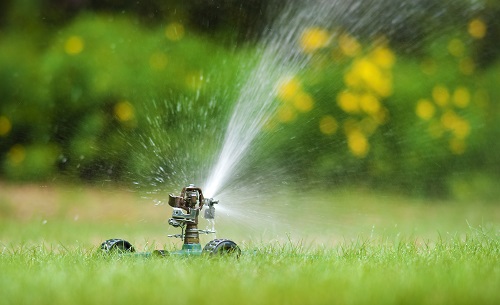
A beautiful lawn is a result of more than just regular mowing and the right nutrients. Don’t underestimate the power of proper lawn care and watering in nurturing a healthy and vibrant lawn. While rainfall can be a boon, homeowners often overlook the need for additional watering.
A well-cared-for lawn, properly established, can withstand weeks without water-induced dormancy. But when rain becomes scarce, giving your lawn a little extra love in the form of supplemental watering becomes essential.
Lawn Care: The Golden Rule of Watering
Water, the elixir of life, can be both a savior and a nemesis for your lawn—too little and it wilts, too much and it drowns. Achieving the right balance is key. An established and robust lawn requires around 1 inch of water per week, ensuring that the top 6-8 inches of soil—the depth of a healthy root system—remains adequately moist.
To gauge how long it takes to deliver that golden inch of water to your lawn, try these two tests as part of your Conway lawn care routine:
Tuna Can Test: Place an empty tuna can in your yard and time how long it takes to fill up. That’s roughly an inch of water and gives you an insight into the duration you should water your lawn.
Screwdriver Test: After watering, check if you can easily insert a screwdriver about 6 inches into the soil. Difficulty implies insufficient watering time.
These tests are most effective with fertile, well-cultivated soil. Good soil offers the right water retention at the root zone, vital for grass health. Inadequate drainage due to poor soil quality leads to waterlogging, while soil lacking organic matter causes rapid drainage, leaving soil parched.
In hot weather, particularly for warm-season grasses, you might need up to 2 inches of water. During drought, warm-season grasses can go dormant—a survival mechanism. Don’t be alarmed; they’ll bounce back when rainfall or water returns.
 Timing is Everything
Timing is Everything
Your lawn’s watering needs aren’t excessive. It’s naturally designed to capture and utilize rain efficiently. Ideally, wait until your grass loses its vibrancy or begins to wilt before watering. A simple test involves walking on the lawn; if your footprints linger, it’s time for hydration.
Speaking of timing, when you water matters too:
Early Morning: Watering before the sun’s intensity peaks is ideal. Cooler temperatures and calmer winds allow the water to seep into the soil, nourishing the roots before evaporation kicks in.
Late Afternoon: If early mornings aren’t feasible, opt for late afternoon (4-6pm). This timing gives the grass ample time to absorb water before nightfall. While evening might seem cooler, late watering can lead to overnight dampness, making your lawn susceptible to diseases.
Frequency Matters
Watering frequency plays a pivotal role in maintaining a vibrant lawn. Daily watering creates shallow roots, making the lawn vulnerable to drying out. In contrast, infrequent yet deep watering encourages robust root systems, rendering your lawn resilient against weeds and diseases.
In warmer months, the average lawn requires watering once or twice a week, amounting to about an inch of water over the week. Adjust based on rainfall. Cooler months demand less frequent watering due to reduced evaporation and increased rainfall.
 Factors such as turf type, soil quality, and environmental conditions influence watering frequency. Fescue, among cool-season grasses, boasts deep roots and high tolerance to drought. Warm-season grasses like Zoysia and Bermuda are equally endowed, requiring less water. Remember, the heat, drought, low humidity, and high winds dictate higher watering needs.
Factors such as turf type, soil quality, and environmental conditions influence watering frequency. Fescue, among cool-season grasses, boasts deep roots and high tolerance to drought. Warm-season grasses like Zoysia and Bermuda are equally endowed, requiring less water. Remember, the heat, drought, low humidity, and high winds dictate higher watering needs.
Soil quality also plays a role. Clay soil retains water better and necessitates less frequent watering compared to sandy soil with rapid drainage.
Choose Your Watering Arsenal
Selecting the right watering method is vital. Explore your options—from sprinklers to smart watering solutions—to find your perfect fit:
Pulsating Sprinklers: Emit water horizontally with vigor, resisting wind interference.
Hose-End Sprinklers: Ideal for smaller to medium lawns, offering flexibility in positioning. Choose from various options to match your lawn’s needs.
In-Ground Sprinklers: A costlier but efficient option. Precisely direct water where it’s needed, and automated schedules save time and money.
Smart Watering Systems: Diverse systems, often integrating with in-ground sprinklers, allow precise control and water conservation.
A Flourishing Lawn: More than Mowing and Fertilizing
A thriving lawn is a product of diligent care, encompassing nutrients, mowing, and—crucially—proper watering. Avoid neglecting your lawn by underwatering or drowning it with excess moisture. Following these tips will usher in a new era of turf health and property allure.
If you’re uncertain about proper watering practices for your specific lawn type, feel free to give Conway Lawn Care Service a call. Your lawn’s lush vitality awaits.
Like our Facebook page for more great info about lawn maintenance.
Conway Lawn Care Service
Conway, SC 29526
843-353-2259
http://conwaylawncareservices.com/
No comments:
Post a Comment